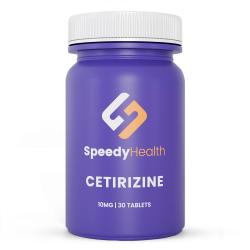- Hay Fever
Hay fever
Buy treatment for hay fever online at SpeedyHealth
Hay fever, also known as allergic rhinitis, is an allergy to pollen. It’s a common condition that affects nearly 50 million adults in the United States.
Continue reading to learn more about the causes, symptoms, and treatment options for hay fever available at SpeedyHealth.

Medically reviewed by Dr. Adrian Rawlinson
Written by our editorial team Last reviewed 15 September 2025
Treatments
Hay Fever explained
What is hay fever?
Hay fever is an allergic reaction to pollen, a fine powder released by plants such as trees, grasses, and weeds.
It is a common condition that causes symptoms such as:
- Runny or blocked nose
- Itchy, watery eyes
- Sneezing
- Itchy nose, throat, or mouth
Less common symptoms may include coughing, headaches, fatigue, or a general feeling of being unwell.
If you have asthma, hay fever can make your symptoms worse, causing wheezing or shortness of breath. In more severe cases, it can interfere with sleep or day-to-day activities.
What causes hay fever?
Hay fever occurs when your immune system overreacts to pollen, mistakenly treating it as a harmful substance. This triggers the release of histamine, which leads to inflammation and the symptoms of hay fever.
Pollen seasons vary depending on your location and climate. In general, in the US:
- Tree pollen is common from March to May
- Grass pollen usually peaks from May to July
- Weed pollen can be present from early spring to early fall
Depending on your location, the timing and types of pollen that affect you may vary.
How is hay fever diagnosed?
Your doctor provider will ask about your symptoms, when they occur, as well as your family and medical history.
If it’s unclear what is triggering your symptoms, or if multiple allergens are suspected, your doctor may recommend a skin prick test. This involves placing small amounts of common allergens on your skin, usually on your forearm or back, then gently pricking the skin to allow exposure. If you’re allergic, you’ll develop a small raised bump at the test site within 15-20 minutes.
Management & treatment
What are the available treatment options?
There are several treatment options to help relieve hay fever symptoms. These include antihistamines, steroid nasal sprays, and eye drops. Many are available over-the-counter (OTC) and some are available through a prescription from your doctor.
Antihistamine tablets
These help relieve sneezing, itching, and a runny nose, but are less effective for a blocked nose.Antihistamine nasal spray
These work quickly to relieve nasal symptoms such as blocked nose, runny nose, sneezing, and itching inside the nose. They do not relieve eye symptoms or other hay fever symptoms.Steroid nasal spray
These contain corticosteroid, a type of steroid, and are effective at relieving all nasal symptoms of hay fever. They can also help ease eye symptoms. Unlike antihistamine nasal sprays, steroid nasal sprays do not work immediately, as it can take a few days for the effects to build. It may take up to two weeks to feel the full benefits.
Eye drops
These are used to relieve itchy, watery eyes. There are two main types: mast cell stabilizer eye drops, which help prevent allergic reactions, and antihistamine eye drops, which provide quicker relief by blocking histamine.
Nasal saline
These sprays contain simple salt water (saline) and can be used to rinse pollen from the nose. They may also help reduce the need for steroid nasal sprays.
How can I manage hay fever?
There are several steps you can take to limit your exposure to pollen and help reduce symptoms:
- Check the pollen count, and if it’s high (a pollen index score above 50), try to stay indoors as much as possible
- Keep windows closed when you can
- Avoid drying clothes outside
- Don’t cut grass or walk through large grassy areas
- Apply petroleum jelly (e.g., Vaseline) around your nostrils to trap pollen and stop it from entering your nasal passages
- Wear wraparound sunglasses or a face mask outdoors
- Shower and change your clothes after being outside
- Vacuum and clean regularly
- Use air filters or purifiers to reduce pollen indoors
Next steps
Can I buy hay fever treatment online from SpeedyHealth?
Yes. At SpeedyHealth, we offer a range of treatment options for hay fever that you can order online.
To get started, complete a short online consultation form so our doctors can review your symptoms and medical history to determine the most appropriate treatment for you.
If approved, your treatment will be shipped free of charge.
Order anytime, anywhere.




See what our customers have to say
See why our customers rated our service 4.5 stars out of 5 on Trustpilot.
Excellent!
4.5Max S , 11 Dec
Best service & fast shipping
Leonard D , 11 Dec
Service was excellent. I made an error in my original online order and customer service got it cancelled so I then reordered correctly. My order was delivered within a week. Great!
M E , 06 Dec
Simple ordering Hassle free purchase Fast delivery FedEx tracking Good products 5 stars all the way
Charles G , 05 Dec
Fast service.
Jeff , 05 Dec
The strength seems to be weaker. The delivery and speed of order was great. I am not able to test but it takes longer to take affect and doesn’t seem to work as well as my last order.
Tom W , 04 Dec
Quick responds to question and








